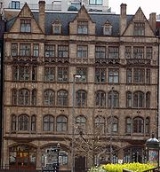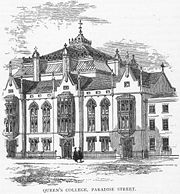
Queen's College, Birmingham
Encyclopedia


William Sands Cox
William Sands Cox was a surgeon in Birmingham, England. He founded Birmingham's first medical school in 1828 as a residential Anglican-based college in Temple Row, where a blue plaque commemorates him on the House of Fraser department store, and in Brittle Street...
in 1828 as a residential college for medical students in central Birmingham
Birmingham
Birmingham is a city and metropolitan borough in the West Midlands of England. It is the most populous British city outside the capital London, with a population of 1,036,900 , and lies at the heart of the West Midlands conurbation, the second most populous urban area in the United Kingdom with a...
, England
England
England is a country that is part of the United Kingdom. It shares land borders with Scotland to the north and Wales to the west; the Irish Sea is to the north west, the Celtic Sea to the south west, with the North Sea to the east and the English Channel to the south separating it from continental...
. It was the first Birmingham institution to award degrees, through the University of London
University of London
-20th century:Shortly after 6 Burlington Gardens was vacated, the University went through a period of rapid expansion. Bedford College, Royal Holloway and the London School of Economics all joined in 1900, Regent's Park College, which had affiliated in 1841 became an official divinity school of the...
. Cox went on to found the Queen's Hospital in Bath Row (Drury & Bateman, opened 1841) as a practical resource for his medical students. The 1828 Medical School became the Birmingham Royal School of Medicine in 1836. It became the Queen's College in 1843 by Royal Charter
Royal Charter
A royal charter is a formal document issued by a monarch as letters patent, granting a right or power to an individual or a body corporate. They were, and are still, used to establish significant organizations such as cities or universities. Charters should be distinguished from warrants and...
.

The college started life in Temple Row and Brittle Street (now obliterated by Snow Hill Station
Birmingham Snow Hill station
Birmingham Snow Hill is a railway station and tram stop in the centre of Birmingham, England, on the site of an earlier, much larger station built by the former Great Western Railway . It is the second most important railway station in the city, after Birmingham New Street station...
). From the date of its Royal Charter in 1843 a large Gothic Revival
Gothic Revival architecture
The Gothic Revival is an architectural movement that began in the 1740s in England...
building (Drury & Bateman, 1843-5) was constructed opposite the Town Hall
Birmingham Town Hall
Birmingham Town Hall is a Grade I listed concert and meeting venue in Victoria Square, Birmingham, England. It was created as a home for the Birmingham Triennial Music Festival established in 1784, the purpose of which was to raise funds for the General Hospital, after St Philip's Church became...
between Paradise Street (the main entrance) and Swallow Street, where a chapel was built to St James.
The building had large lecture theatre, laboratories, anatomical rooms, a dining hall and apartments for seventy students.
The building was given a new buff-coloured terracotta
Architectural terracotta
Terracotta, in its unglazed form, became fashionable as an architectural ceramic construction material in England in the 1860s, and in the United States in the 1870s. It was generally used to supplement brick and tiles of similar colour in late Victorian buildings.It had been used before this in...
and brick front in 1904, and later demolished with its grade II listed façade incorporated into an office and residential block, Queen's Chambers, opposite the Town Hall entrance.
Following internal quarrelling and law suits the medical and scientific departments split from the college and moved to the nearby Mason Science College
Mason Science College
Mason Science College was founded by Josiah Mason in 1875, the buildings of which were opened in Edmund Street, Birmingham, England on 1 October 1880 by Thomas Henry Huxley...
, leaving the theological department, which moved in 1923 to Somerset Road in Edgbaston, becoming the current Queen's College. Mason Science College became the University of Birmingham
University of Birmingham
The University of Birmingham is a British Redbrick university located in the city of Birmingham, England. It received its royal charter in 1900 as a successor to Birmingham Medical School and Mason Science College . Birmingham was the first Redbrick university to gain a charter and thus...
in 1900 and moved to a new campus in Edgbaston.

